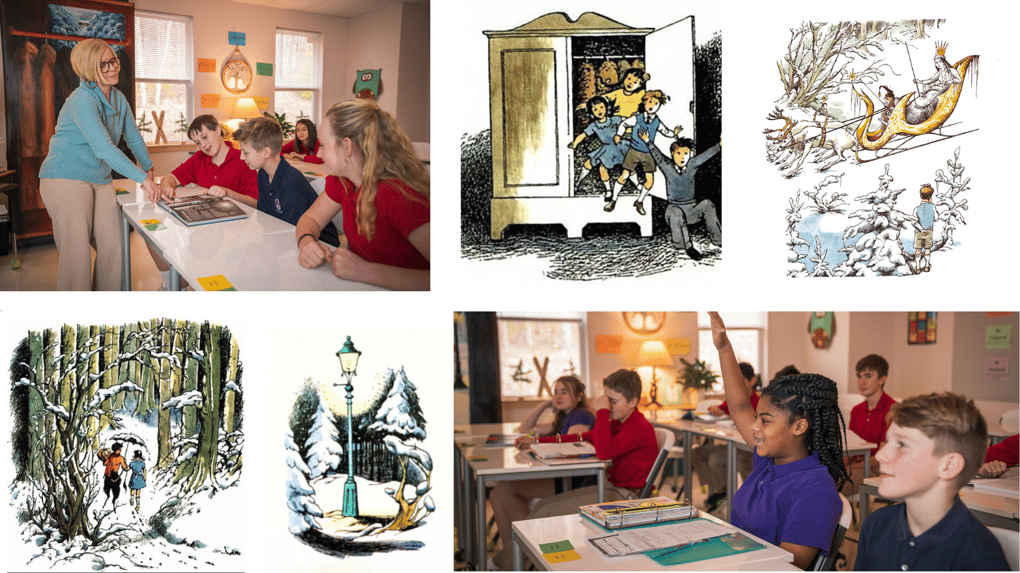-May-15-2025-01-33-29-8509-PM.png)
At Faith Christian School, middle school students journey through C.S. Lewis’ Chronicles of Narnia, beginning in fourth grade and continuing through seventh. These stories captivate imaginations while helping students explore deep biblical truths—such as courage, redemption, faith, and the nature of good and evil. Through classroom discussions and read-alouds, students make meaningful spiritual connections that can last a lifetime. The goal is that these powerful narratives plant seeds of truth and draw students into a deeper relationship with Christ.
Stories have a unique way of capturing the hearts and minds of children as well as adults. They take us to distant lands, expand our imaginations to entertain the idea of talking with animals, and allow us to visit with favorite characters we can only encounter in the pages of a well-written story. Not many authors quite compare with the masterful, imaginative writings of C.S. Lewis.
One of the things I really love about teaching middle school literature here at Faith Christian School is the privilege of reading Lewis’ amazing stories aloud. Students are first introduced to C.S. Lewis’ fantasy novel series The Chronicles of Narnia the summer before fourth grade with their reading of The Magician’s Nephew. In its pages, they learn how the land of Narnia came to be, experience the power and consequences of their choices, and see the natural, created order of God’s world.
Then, they meet Lucy, Edmund, Peter, and Susan and step through the wardrobe into the magical land of talking lions, fauns, beavers, and centaurs found in The Lion, The Witch, and The Wardrobe during fourth grade. Students explore the powerful concepts of good and evil, the dangers of deception, and the biblical truth that God is not safe, but He is good.

Students venture on with summer and classroom reading during sixth grade, with Prince Caspian and Voyage of the Dawn Treader. Through the pages of these two stories, students have the opportunity to see characters demonstrate courage and leadership, face the destructive consequences of pride and selfishness, and then the restorative power of redemption.
Finally, in seventh grade, students experience The Silver Chair and The Last Battle as classroom read-alouds. When fully engaged with masterfully crafted stories through classroom discussion, students naturally begin to make deeper connections with biblical truth and ask powerful questions about themselves and their walk with Christ. With these final two stories in the Narnia series, students discover the consequences of being distracted from God’s truth, how to stand firm in their faith, what Christ’s return will be like, and the beauty of heaven.
In his essay, “On Three Ways of Writing for Children,” Lewis states, “I am almost inclined to set it up as a canon that a children’s story which is enjoyed only by children is a bad children’s story. The good ones last.” He contended that stories written for children have the infinite power to go far beyond what appears to be simplistic and one-dimensional.
The characters, lands, and plots that Lewis interweaves create a beautiful tapestry that students enjoy coming back to each year, going a bit deeper with each novel read. What begins with a captivating children’s story just might spark a valuable conversation or create a stone of remembrance that the Lord uses later in life.
One of my favorite quotes from The Last Battle is, “In our world, too, a stable once had something inside it that was bigger than our whole world. Now, at last, they were beginning Chapter One of the Great Story which no one on earth has read: which goes on forever: in which every chapter is better than the one before.”
My prayer for my students is that through the power of story, God will hide biblical truths in their hearts that help them recognize and desire the good, true, and beautiful and draw them into a deeper relationship with their Savior.
- Wendy Steele, Middle School Humanities


-1.png?width=296&height=50&name=Back%20To%20All%20Stories%20(1)-1.png)